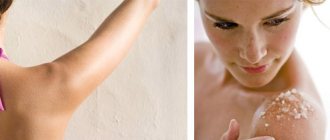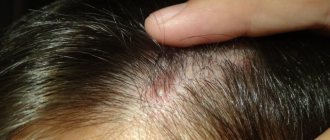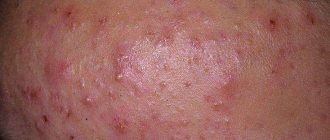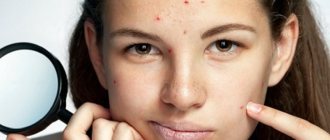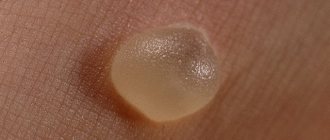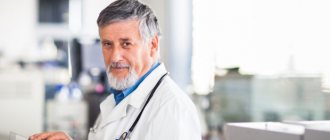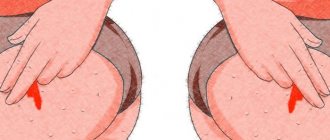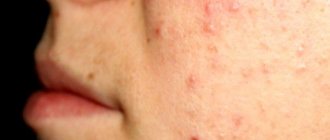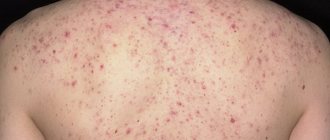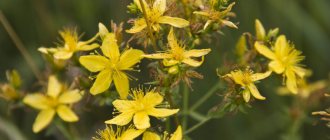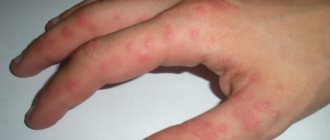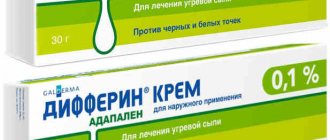Causes of acne
Acne on the stomach appears for many reasons. Acne can form in young girls as a result of age-related hormonal surge . Under the influence of testosterone, the sebaceous glands are activated, which begin to secrete excess sebum. The result is purulent rashes all over the body.
Hormonal imbalance can also be caused by pregnancy. Such problems are observed more often in the first trimester.
Among the causes of rashes, experts identify factors such as:
- infectious diseases,
- dermatitis,
- allergic reactions,
- gastrointestinal diseases,
- shingles,
- venereal infections.
In middle-aged women, acne may be caused by Cushing's syndrome or polycystic ovary syndrome. During menopause, acne is caused by a lack of the hormone estradiol.
The cause of acne can be a simple neglect of hygiene, wearing synthetic clothing (especially in hot weather), and poor quality detergents.
If pimples itch and itch , they are infectious or allergic in nature . In the latter case, one can observe the maturation of acne, which gradually increases in size, and then suppuration occurs.
Small bright red rashes located over the entire surface of the body appear with infectious diseases such as measles, scarlet fever, and smallpox. The illnesses are accompanied by high fever, weakness, and sweating. In severe cases, a person experiences fever and confusion.
Pain and severe itching are observed in rashes caused by fungi and parasites. Shingles is characterized by the formation of watery papules located on the waist, buttocks and thighs. Similar symptoms are observed with scabies. As the disease progresses, small papules merge into conglomerates.
Pimples in the lower abdomen can be caused by the genital herpes virus . With this disease, swelling and redness of the skin in the affected areas is observed. The bubbles merge into separate islands.
The second stage of syphilis manifests itself in a similar way. Acne takes the form of papules filled with colorless liquid or nodules. With syphilis, the rashes are often located and have a bright pink color. They are painless and do not bother you at all.
Small pimples accompanied by severe itching are characteristic of dermatitis of various etiologies, allergies and eczema. In this case, dry pimples are observed, which flake off, forming a crust.
Important! If a rash occurs, accompanied by tissue swelling or severe itching, you should immediately contact a specialist.
What types of acne are there?
A pimple can be with or without inflammation
. The first one is more unpleasant and dangerous, because it itches, hurts and can cause the spread of infection.
Types of non-inflammatory acne:
- Blackheads (open comedones).
- White bumps (closed comedones).
Types of inflamed pimples:
- Small inflamed pimples (papules).
- Ulcers (pustules).
- Cysts (concentration of inflamed codemones in one place).
- Nodules (deep subcutaneous pimples, usually painful).
If the cause of non-inflamed acne
, they can turn into inflamed ones. In this case, further infection by bacteria occurs, causing the tissue to swell. Under no circumstances should such formations be squeezed out - there is a very high probability of damaging the skin. The rash must be treated. The technique must be appropriate, otherwise the situation will only get worse.
Classification of skin rashes
Experts classify acne depending on the size of the affected area, the density of the rash and the presence of purulent contents:
- The comedonal form is a closed formation that appears as a result of blockage of the sebaceous ducts by keratinized scales of the dermis.
- The papulopustular form is characterized by the presence of comedones and papules, interspersed with pustules (open pimples).
- The nodular form is distinguished by the predominance of pustules interspersed with papules. There is redness and swelling of the tissues.
- The conglobate form or multiple acne is a severe stage of acne, in which inflammation covers large areas of the skin.
Dermatologists distinguish 4 degrees of acne :
- With the first, a few comedones and papules without pus are observed.
- The second degree is characterized by the presence of inflammation and pustules appear.
- At the third stage of the disease, deep acne joins the existing manifestations. The area of acne spread increases. Nodular formations appear, the rashes merge into conglobates.
- The fourth, severe form is characterized by pain, the presence of a large number of boils with purulent contents, and hyperemia of the skin.
The video shows methods of treating stage 2 acne. We have a separate article about the causes of acne on the face.
Why do acne appear on the forehead?
Such troubles appear for various reasons.
. Contrary to popular belief, acne on the face can affect not only teenagers, but also adults. This feature is typical for those who sweat a lot and those whose sebaceous glands are disrupted. The appearance of pimples on the forehead can be prevented by regularly washing your face with soap. If this does not help, it is better to check the entire body for abnormalities.
Although boys neglect hygiene more, girls' foreheads
may also
suffer from rashes
. The reason for this is low-quality cosmetics. Also, acne in women can appear while dieting. During such a period, the body may not receive enough important substances, which causes internal pimples to appear throughout the body.
How to identify the cause of acne on the stomach in women?
Before starting to treat rashes on the body, it is necessary to determine their nature. This is especially true for acne, which is widely localized, does not go away for a long time and is not susceptible to the effects of conventional bactericidal drugs.
The following tests may be prescribed to the patient:
- if syphilis is suspected, blood test for CSR;
- if scabies or demodicosis is suspected, culture to determine pathogenic microflora;
- for age-related teenage acne - hormonal profile;
- for acne of unknown etiology - blood biochemistry to determine the malfunction of internal organs.
If the patient has already been treated with antibiotics, the specialist may prescribe an additional test for drug resistance of microorganisms that cause acne. If a patient consults a dermatologist for the first time, the doctor may well prescribe treatment without laboratory tests.
What to do to get rid of red pimples?
If you have acne on your body, you must first determine the cause of its appearance.
Then you should take your diet very seriously and stop eating all harmful foods that have very little benefit. Also, stop using cosmetics for a while or replace them with something else. If all this does not give the desired result and the acne does not disappear, then you should contact a specialist. First, he must order examinations and only then diagnose you and choose treatment. In such cases, the doctor may send you to check the thyroid gland (ultrasound), take tests for hormones, hormone and biochemical tests, and also do a coprogram. Based on the results of tests and examinations, the doctor will determine the nature of your acne. If they are the result of an allergy, then you can cope with them yourself. If the reason is different, then the doctor may prescribe hormonal drugs or other medications if the reason is very serious. In order to prevent the appearance of acne, you need to follow a few simple rules.
Use antibacterial soap;
If there is no inflammation on the body, then you can use body scrubs;
Don't forget about regenerating ointments or creams.
Ultrasound, ozone therapy, mud therapy or mesotherapy will also help in the fight against acne.
Attention!
The information on the site cannot be used as a basis for making a diagnosis or starting self-medication! No website can replace a visit to a doctor. Do not self-medicate based on information on the Internet, it is dangerous!
Acne on the body and face is a delicate problem that, unfortunately, is relevant for any age.
Externally, acne on the skin can manifest itself in different ways. This will depend on the cause of their occurrence, as well as on the severity.
The reasons may be different, but the main ones will be: failure to comply with hygiene standards, the influence of irritating external factors, or an imbalance in the functioning of the body (for example, due to illness). Separately, experts highlight the psychological reasons for the appearance of acne.
When deciding how to get rid of acne on the body or face, you need to understand that effective acne treatment involves eliminating the underlying problem.
Without this, any remedy or ointment will be unproductive and will give only temporary results.
Acne on the body of a child or an adult, as a rule, appears due to blockage of the pores with the secretion of the sebaceous glands.
Normally, the skin always secretes a certain amount of sebum, which performs protective functions - retains moisture in the skin, participates in thermoregulation processes and prevents infection.
The secreted secretion is a mixture of natural fats. The volume of sebum secreted by the skin is determined by hormones.
Secretion is especially affected by male (androgens) and female (estrogens) hormones. Androgens increase sebum production, while female ones decrease it.
As a rule, the appearance of acne on the body and face is due to several reasons:
- increased sebum production by the glands;
- hyperkeratosis - excessive thickening of the upper (keratinized) layers of the skin;
- excessive activity of skin microflora, which is useful during normal functioning, but in excess provokes various disorders;
- inflammatory processes and infections.
As the skin produces more oil, the sebaceous glands increase in size, causing enlarged pores to appear on the body.
At the same time, at the mouths of the sebaceous ducts, the layers of keratinized epithelium become thicker. Why do the ducts become clogged? The produced sebum cannot come out and clogs the pores further, stretching their cavities.
This creates favorable conditions for the proliferation of bacteria, an increased concentration of which will be unfavorable for the skin and can cause inflammatory processes.
Added to all of the above is that in a painful state, the skin becomes vulnerable to infection from the outside.
Pimples can appear anywhere there are pores: on the face, back, shoulders, arms or legs.
As a rule, it all starts with a comedone - a pore clogged with sebum. In the future, the comedone may increase in size and become a blackhead.
The oil that fills it, close to the surface of the skin, will oxidize and become dark in color, causing the head of the eel to turn black.
But if the comedonal cavity does not have access to the surface of the skin, then the secretion of the sebaceous glands will remain white, and whiteheads (milia) will appear from it.
When an infection enters a comedone or with increased proliferation of local bacteria, an inflammatory process begins, resulting in the formation of either a papule (nodule) or a pustule (abscess).
A papule is a formation on the skin, which, as a rule, is formed from closed comedones, which is why it does not have a pronounced white head.
The structure of the papule includes suppuration and swelling of nearby tissues. The size of the inflamed nodule can range from 1 mm to 3 cm.
In the area of the papule, the swollen skin may acquire a pink or even bluish tint. Papules formed at the site of an open comedone have a black head.
A pustule is a cavity formation containing pus. It can arise from papules or independently as a result of inflammatory processes in the skin. Often, when experiencing irritation reactions on the body, people encounter pustules.
Rashes, the appearance of which is not caused by a comedone, but by inflammation of the hair follicle, are called acneiform.
If pimples on the body itch and have a watery head, then you should immediately consult a doctor, as these may be symptoms of a serious illness - chickenpox or measles.
Folk remedies for acne treatment
When treating mild acne, various herbs and herbs are successfully used. Plants that have an astringent, anti-inflammatory, wound-healing effect are used, such as:
- chamomile,
- marigold,
- oak bark,
- celandine.
Herbal decoctions and infusions are used for baths and rubdowns.
Oak bark and sea salt
The plant material is crushed, poured with water (3 tablespoons per 800 ml) and boiled for half an hour, then filtered. The bath will require half of the resulting solution. Add a glass of pure sea salt to this.
The product helps get rid of acne and alleviates the condition of patients with dermatitis . The procedures are carried out every other day, combined with pharmaceutical ointments and solutions.
Tripartite sequence
The plant relieves swelling and itching, disinfects and dries the skin. Used alone or in combination with chamomile flowers. For 400 ml of water you will need 2 tbsp. spoons of ground vegetable raw materials.
The bath is taken every other day until the symptoms are completely eliminated.
Advice! Apple cider vinegar helps cope with itching and relieve swelling. You need to choose a natural product. It is better if it is made at home.
Pharmacy drugs
The choice of over-the-counter medications for acne treatment is quite extensive. They differ in cost, but some inexpensive products provide an excellent disinfecting and drying effect.
- Such drugs include an alcoholic infusion of calendula and a solution of salicylic acid, chlorhexidine.
- Among the inexpensive ointments one can highlight “Levomekol”, “Zinc paste”, and synthomycin emulsion.
Special remedies for stomach acne include:
- The modern product “Zinerit” was developed to combat juvenile acne. The composition contains zinc and erythromycin.
- The drug "Skinoren" is effective for mild acne of a hormonal nature. Contains azelaic acid.
- "Dalacin" gel contains antibiotics from the lincosamide group. Has a pronounced anti-inflammatory effect.
- Gel "Eclaran" has an anti-inflammatory and exfoliating effect.
Important! Pregnant and lactating women should only use anti-acne medications after consulting a doctor.
Main symptoms
It is difficult to accurately determine the symptoms of abdominal rashes. After all, each person experiences acne differently. But it’s still possible to imagine the general picture.
- The most common symptoms include:
- itching _ With allergic or infectious diseases, itchy skin appears. It can be strong or moderate, depending on the stage of the disease;
- redness _ The site of acne may periodically or constantly become red, in rare cases swollen;
- unpleasant, painful sensations . In some cases, the rash may be accompanied by pain. This could be a sign of shingles. The appearance of pain indicates damage to the nerve endings.
Proper nutrition
Diet is one of the important components in the treatment of acne. Adjustment of the diet is necessary during the therapy phase, although experts recommend adhering to certain dietary restrictions at all times. A diet that will help you get rid of acne is based on the basic principles of proper nutrition.
- The main recommendation is to avoid fast food , canned foods, smoked foods, hot seasonings, excessively fatty foods and store-bought sauces.
- limit chocolate, strong coffee, sweet sodas and juices, baked goods, white flour products, and refined foods.
- The basis of the diet should be cereals, vegetables, herbs, and fruits. Foods rich in vitamins A and C are suitable.
- The body will be provided with proteins from cottage cheese, lean fish, poultry, and meat. Some experts advise against drinking milk, claiming that it contains hormones that can provoke acne relapses.
Detailed video about diet for acne.
Chest and décolleté
Why can purulent acne appear on the body? Most often this is an allergy to shower gel or washing powder. They can appear as a reaction to spicy or fatty foods, and some drinks that contain large amounts of sugar. And, of course, seafood.
You can get rid of acne in the décolleté area with baking soda. To do this, you need to mix it with a small amount of water to make a paste. Massage the skin with this product for half a minute and rinse with water.
Which doctor should I contact?
If self-treatment of acne does not bring results, you should seek help from a specialized specialist . First you should visit a dermatologist , who, if necessary, will refer you to other doctors.
For acne in women and girls, it is recommended to visit a gynecologist who will conduct an examination and select hormonal treatment with oral contraceptives.
- Severe acne is treated with tetracycline antibiotics (Doxycycline, Oxytetracycline). Erythromycin ointment, Clindamycin, is used externally. Retinoids (vitamin A derivatives) are also used to normalize the processes of keratinization of epithelial cells.
- For topical use, Klenzit or Effezel gels containing adapalene are recommended. Isotrexin ointment is used in the treatment of resistant strains of Propionibacterium acnes bacteria. The drug Isotretinoin, which belongs to the group of retinoids, is prescribed for oral administration. Additionally, zinc preparations (Zincteral) are used to compensate for the deficiency of this microelement.
Therapy is aimed at inhibiting the activity of the sebaceous glands and reducing inflammation. Chemicals such as salicylic and glycolic acids are used to exfoliate the top layer of skin. They eliminate dead cells, the excess of which leads to clogging of the sebaceous glands. The drying effect is provided by ultraviolet rays.
Allergic acne is treated by taking histamines . This could be Suprastin, Tavegil, Diazolin or topical drugs (Fenistil).
In some cases, they are combined with adsorbents, such as activated carbon, Enteros Gel. An important factor in therapy is the identification and elimination of the allergen.
Important! The appearance of acne of unknown etiology is a reason to contact an immunologist. They may indicate a weakened immune system.
Acne that appears as a result of an infectious lesion of the body requires not only immediate treatment, but also isolation of the patient from contact with healthy people. If infected with skin parasites, it is necessary to disinfect the room. Bed linen and clothes are washed at high temperatures and carefully ironed on both sides.
Principles of acne treatment
The appearance of white or red pimples on the abdomen of a child, woman, or man requires an evaluation by a dermatologist. Many people make one mistake - they try to fight the problem with the cosmetics they use for skin care. In most cases, such approaches will not help. We should not forget that antibiotics may be powerless against viruses, just like formulations with hormones.
Here are some basic tips for dealing with breakouts:
- Shingles. Viral pathology requires the use of antiviral drugs. In this case, strengthening the immune system and avoiding alcohol and junk food also play an important role. Healing will be facilitated by quality rest and the elimination of stressful situations.
- Prickly heat. It can haunt not only children, but also adults, especially those who are overweight. Bathing in chamomile decoction, air baths, using baby powder and regular hygiene procedures can help prevent illness.
- Allergy. If acne appears on the stomach and there is a suspicion of an allergy, it is not enough to start taking antihistamines. First of all, it is necessary to establish the type of provocateur and eliminate its effect on the body. Additionally, local care for the rash will be needed to prevent it from becoming infected.
- Molluscum contagiosum. In childhood, special therapy is usually not carried out; the disease disappears on its own within a few months. In the case of adults, various innovative surgical techniques are used. They allow you to eliminate aesthetic defects.
Only professional treatment will help in the case of a rash caused by sexually transmitted diseases. Any experiments with such elements can only worsen the patient’s general condition. At the same time, local therapy will not bring any result if the disease itself is not affected.
Consequences of acne
Untimely treatment of acne often leads to the formation of noticeable marks on the skin . If acne should be treated by a dermatologist, then a cosmetologist will help eliminate the consequences of the problem. One of the most effective procedures is dermabrasion.
Infrared laser solves the problem of acne marks. Under its influence, scar tissue seems to evaporate, being replaced by new cells. The procedure is quite traumatic; it will take about a week for the skin to recover. A lasting noticeable effect is achieved after a month.
Advice! Procedures associated with intensive exfoliation should be carried out in the fall. This will avoid the formation of unsightly pigment spots caused by UV rays.
Our readers write
My experience with acne treatment
Good afternoon
She persistently tried to cure me with a variety of ointments and gels, tablets and traditional medicine. but nothing worked. It seemed that there would always be more than love between us. We will also be connected by acne. It was very, very unpleasant.
And then somehow my beloved girl, in search of another acne remedy, came across this amazing article on the Internet. Here we talked in detail about such a remedy for acne as.
We decided to try it right away - maybe we’d be lucky too. , received it by mail and began to act.
Surprisingly, I was able to notice the first results within a week! The pimples not only began to decrease in size, they stopped being red, stopped itching and began to literally go away.
My beloved liked it so much that she decided that the course of treatment should be completed completely. And we were right! Only a month has passed and now I have clear skin - not a single pimple, not a single scar or other trouble!
I am very grateful to my girlfriend for literally saving me from acne. It’s so great to look in the mirror and see your face, not acne!
How Inblanc changed my life
Hi all! My name is Marina, I am 23 years old, and I am the mother of a charming daughter. But my motherhood is overshadowed by one unpleasant circumstance - every day in the mirror I see ugly pigment spots on my cheeks and forehead.
I tried everything I could to get them out! I tried both celandine and chamomile, and even signed up for chemical peeling, but thought better of it in time.
And then somehow my husband, quite by accident, came across this amazing article on the Internet, which described a milk for the treatment of age spots. And knowing about my problem, without saying anything, I ordered this product.
I received my unexpected gift literally a week later. And on the very first day I smeared the hated spot on my forehead and a couple of spots on my cheeks 5 times a day. I don't think it was much - the hyperpigmentation on my face was too strong.
This went on for a week. And literally on the 10th day from the start of use, it began to seem to me that my spots began to lighten. I immediately questioned my husband, and he confirmed my joy. And to accurately confirm my guess, I went to my friend. And do you know what she said?
- What happened to your spots? They are no longer so noticeable, my dear! Let me try to cure my freckles with this drug! .
If you had seen my face 5 years ago, you would have been simply horrified! There were all kinds of pimples - big and small, they were everywhere. I was ashamed to go out. I was treated with available folk methods - chamomile and celandine. They didn't help as much as I would have liked.
I developed complexes, my mother tried to help me, but the acne didn’t want to go away. It seems that I have already come to terms with my problem. And I even learned to live with acne.
But one day a friend of my mother came to visit us. And seeing the terrible state of my face, I was very surprised that we still haven’t bought an amazing product. She gave us its name - and that’s how I learned about Acnelocin. I read it
Quite often, the appearance of acne can indicate that some hormonal changes are occurring in the body. Although quite often adults also face this very unpleasant problem. Then there may be more than enough reasons for the rash and they can indicate a variety of diseases or problems with the body. As soon as you notice that you have acne, and you are clearly no longer in adolescence, then you should start by changing your diet and working on a healthy body.
Prevention
To avoid acne, you need to eat a healthy diet and quit smoking and alcohol. You will have to make some adjustments to your wardrobe. For everyday wear, you should choose clothes and underwear made from natural fabric. Avoid tight belts, constricting corsets, which impair blood circulation.
For body care, use products without fragrances or dyes. Choose lotions and creams that suit your skin type.
Keep an eye on the expiration date of your cosmetics. Moisturize your skin after a shower, avoiding drying it out. This will avoid keratosis, which is one of the causes of acne.
